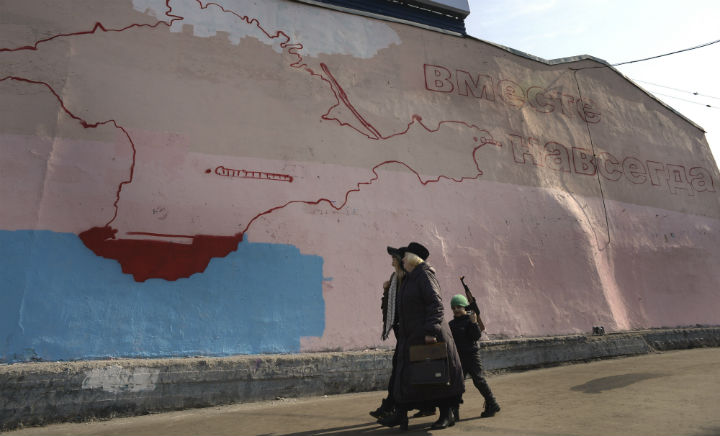Russia opened its arms to Crimea last week, with Vladimir Putin’s signature and, in trademark Russian pomp and circumstance, a fireworks display.

Now comes the job of actually making the territory and its citizens a part of the Russian Federation.
Crimeans are already receiving their Russian passports and the Russian ruble was set go into circulation on Monday.
READ MORE: Russia bans entry to 13 Canadian lawmakers, officials
But the transition – or reunification, as Russia calls it – is going to come at a cost to both the Kremlin and Crimea.
Russia is going to pick up quite a hefty tab to bring Crimea into the federation, but the financial benefits Crimeans may see from being a part of a wealthier nation could come at a different cost.
Bridging the gap
Crimea may see money being poured into the bridge connecting it to the rest of the country.
A 4.5-kilometre span of the Strait of Kerch divides the Crimean peninsula from Russia. The Kremlin has already announced plans to build a vehicle and rail bridge. On news of the announcement last week, Russia Today reported the bridge would come with a price tag of about $1.4 billion and would take approximately three and a half years to build.
But, that was already in the works. Russia’s Ria Novosti noted Russia and Ukraine reached an agreement to construct the bridge in December, while former President Viktor Yanukovych was still in power.
The post-Yanukovych interim government, which is no friend of Moscow’s, put those discussions on hold in February, following Yanukovych’s impeachment, Russia Today reported.
If you build it, will they come?
Crimea was already a holiday destination, particularly the Black Sea resort city of Yalta. The overwhelming majority of Crimea’s holidaymakers, 70 per cent, came from Ukraine. Russia, meanwhile, accounted for only a quarter of the region’s visitors.
In better days, Ukrainians and Russians could enter each other’s countries will little fuss.
As of Sunday, Ukraine’s border with Crimea is closed. That may not be a permanent closure, but with the situation still tense and Ukraine concerned about Russian troops amassing along other points of their shared border, you can bet Crimea’s tourism industry – a very vital part of its economy – will suffer.
READ MORE: Tourism officials promote travel to Ukraine at Berlin fair
For now, the only flights heading in or out of Crimea are to and from Moscow.
Russia, however, is no stranger to spending a lot of money when it wants to develop a tourist destination.
Case in point: Sochi.
Russia reportedly spent $51 billion dollars – an estimate that is in dispute – on the 2014 Winter Olympics in Sochi, making it the most expensive Olympic Games ever.
The money wasn’t just spent on building the sports facilities, but also on major road upgrades, new public transportation and a brand new airport. There were also enough hotel rooms to host 40,000 people in both the coastal areas of Sochi and Adler, as well as in the Krasnaya Polyana ski resort area.
While it’s yet to be seen if the investment will pay off in the long run, Sochi’s next big event has now been taken off the schedule.
It was due to host the G8 summit in June. But, the members of the G7 have moved to pull the meeting from Sochi, in the wake of Russia’s annexation of Crimea, and have their own meeting in Brussels.
READ MORE: Harper, fellow G7 leaders to suspend G8 meetings until Russia ‘changes course’
Russia also pumped huge sums of money to rebuild the Chechen capital of Grozny, following the two Chechen wars.
The UN even honoured Grozny and Russia’s redevelopment of the city in 2009. Six years earlier, the world body dubbed Grozny the “most destroyed city on earth.”
The city of 271,000 people has gone from shelled-out buildings to shiny skyscrapers.
Crimea may not be Chechnya, but it is a good gauge of how much Russia is willing to spend when it wants to.
A report from The Moscow Times noted Crimea will become “one of Russia’s poorest regions” and it won’t be cheap to transform its “dilapidated infrastructure.”
Love of country, or else
But with Russian development money comes Russian authority.
Amnesty International has warned Crimeans face a “grim human rights predicament.”
In a blog post, the human rights organization inferred the Crimean people will now have to contend with Russian laws that many foreign organizations and governments consider oppressive, ones they wouldn’t be subject to under more European-style legislation.
“If anyone really thinks that the raising of the Russian flag over their civic buildings will do anything to improve governance, root out corruption, or strengthen democratic participation in the running of their affairs, they are likely to be quickly disabused of the notion – and left with little room to object,” Amnesty’s Secretary General Salil Shetty wrote.
Some of the legal changes Crimeans will be subjected to include restrictions on public demonstrations and NGOs, legislation that prohibits the promotion of lesbian, gay and bisexual relationships, and a strict criminal libel law that is seen as putting limits on freedom of expression.





Comments